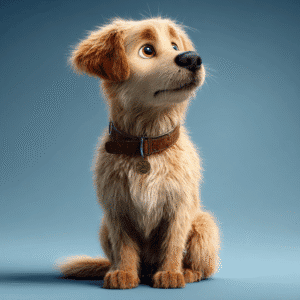Take the loyalty and work ethic of a Labrador, mix it with the sweetness and fluff of a Golden Retriever, and you get the Goldador. This crossbreed is winning hearts as both a family companion and a working dog, combining the best of both parent breeds — with a double dose of “please throw the ball again.”
Owner insight: “My friend says that the ‘Goldador’ they had was the best hunting dog ever, and best pet ever.”
Not sure if you’re more Lab or Golden? Try the Which Dog Breed is Best for Me? Quiz before you decide.
Great Names for a Goldador
With their sunny temperament and goofball charm, Goldadors deserve names that fit both their retriever roots and their playful personality. For more inspiration, check out our Dog Name Generator.
- Golden-inspired: Sunny, Honey, Amber, Ray
- Lab-inspired: Scout, Jet, Bailey, Willow
- Mix-nods: Goldie, Labby, Nugget, Biscuit
- Fun picks: Waffles, Fluffybutt, Zoomie, Sofa, Wiggle
Pickles’ Aside: “Call one Waffles and I guarantee your breakfast is never safe.”
Exercise
Goldadors inherit the Lab’s stamina and the Golden’s playfulness, so exercise is non-negotiable.
They need:
- 1–2 hours daily of walks, fetch, or swimming.
- Plenty of training games to work their brains.
- Early joint care — don’t overdo long runs while growing.
Owner insight: “They are fantastic, though they all think they are lap dogs! Great with kids … you need to limit exercise in the first year, short walks and playing in the garden is plenty for big soft bones.”
Working Breed Warning
Goldadors are bred to do. If you don’t give them enough exercise, stimulation, or a “job,” they’ll make their own — usually involving chewed shoes or redecorated gardens.
Pickles’ Aside: “Bored Goldador? Say goodbye to your slippers.”
Temperament
Goldadors are affectionate, playful, and loyal to a fault. They thrive on human company and don’t do well if left alone for long.
- Superb family dogs — patient and loving with children.
- Social butterflies — friendly with strangers, sometimes too much so.
- Eager to please — they want to be part of everything you do.
Owner insight: “She looks like a Lab but has the soft coat of a Golden Retriever. Love her so much.”
Training
Smart, eager, and food-motivated — Goldadors are a trainer’s dream. But they need consistency, or they’ll happily bend the rules.
- Start early with recall and loose-lead walking.
- Positive reinforcement works like magic.
- Watch the teenage phase — they can get cheeky.
Need backup? Try the World’s First AI Dog Trainer to keep them engaged.
Strangers & Watchdog Potential
Goldadors are more likely to greet strangers with a wag than a growl. Don’t count on them as guard dogs.
- Friendly greeters — excellent therapy dogs.
- Alert barkers, but rarely intimidating.
- Better as hosts than watchdogs.
Other Animals
With the Golden’s tolerance and the Lab’s easygoing nature, Goldadors usually get along well with other dogs, cats, and even smaller pets (if raised together). Prey drive is generally low compared to terriers or sighthounds.
Pickles’ Aside: “Best friends with everyone… except your sandwich.”
Grooming
That mix of coats means Goldadors shed — a lot.
- Brushing 2–3 times a week (daily in shedding season).
- Bathing every few months or when muddy.
- Ear cleaning is vital (Labs and Goldens are both prone to ear infections).
Health
Being a cross doesn’t mean Goldadors escape health issues. They inherit risks from both parent breeds. Common concerns:
- Hip and elbow dysplasia
- Progressive Retinal Atrophy (PRA)
- Cataracts
- Ear infections (floppy ears + water love = problems)
- Obesity occurs when exercise and diet aren’t managed
Owner insight: “They aren’t a breed at all … very unlikely these dogs will be healthy … You probably won’t have full OFA test scores or parental histories.”
Always ask breeders for health test certificates — hips, elbows, eyes, and ideally, DNA tests. For help, see our Best in Breeder Guide.
Cost of Ownership (UK)
Goldadors aren’t cheap — and they eat like, well, a Labrador.
- Puppy price: £800–£1,500 (though crossbreeds vary)
- Food: £40–£70/month
- Insurance: £30–£60/month
- Routine vet care: ~£300–£500/year
- Unexpected costs: joint surgeries or eye treatments can run into thousands
Famous Owners & Moments
Goldadors are growing in popularity, especially as assistance dogs — combining the Lab’s trainability with the Golden’s gentle nature makes them excellent guide and therapy dogs.
Myth-Busting
| Myth | Reality |
|---|---|
| Crossbreeds are always healthier | Not necessarily — Goldadors can inherit issues from both parents. |
| They don’t shed | They do. A lot. |
| They don’t need much exercise | Wrong — they’re high-energy working dogs. |
| They make good guard dogs | Too friendly — intruders might get kissed. |
Goldador FAQs
- Are they hypoallergenic? No — they shed heavily.
- Do they make good family dogs? Yes, brilliant with children.
- How much exercise? 1–2 hours daily.
- How long do they live? 10–14 years.
- Are they easy to train? Yes — smart and food motivated.
Thinking of Bringing Home a Goldador?
If you want a bouncy, affectionate companion who’ll shower you with loyalty (and hair), the Goldador could be perfect. Just be ready for long walks, daily brushing, and a dog that wants to be glued to your side.
Before you take the plunge, get organised with our New Puppy Paw-rent Planner. And once your Goldador is settled, why not celebrate them with a Custom Cartoon Pet Portrait?
Pickles’ Aside: “Best bits of two retrievers, double the fluff on your sofa.”
Breed Stats
- Origin: Cross of Labrador Retriever × Golden Retriever
- Weight: 27–36 kg
- Height: 55–61 cm
- Lifespan: 10–14 years
- Best Trait: Loyal, family-friendly, eager to please
- Challenging Trait: Heavy shedding, high energy

